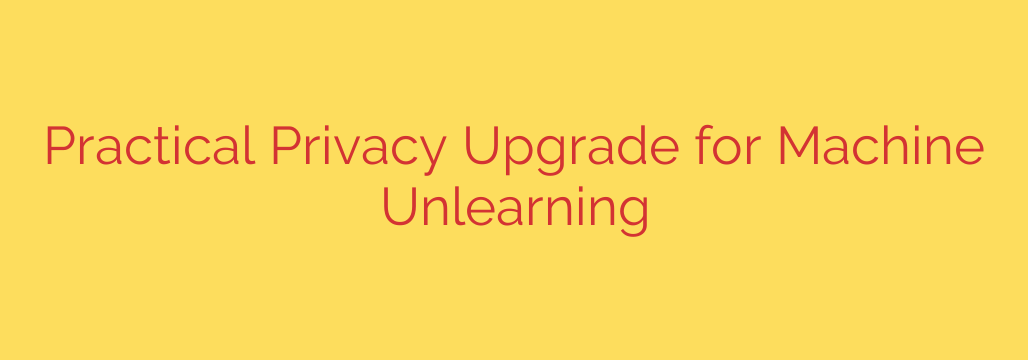
The Next Frontier in AI Privacy: Why Machine Unlearning Needs a Security Upgrade
In the age of artificial intelligence, data is the new oil. But with this valuable resource comes immense responsibility. As users become more aware of their digital footprint, regulations like GDPR and CCPA have empowered them with the “right to be forgotten.” This has pushed the tech world to develop a crucial capability: machine unlearning, the process of making an AI model forget a specific piece of data it was trained on.
While machine unlearning is a significant step forward, a critical question remains: is it enough to truly protect user privacy? The answer, it turns out, is more complex than a simple “yes.” A new approach is needed to bridge the gap between removing data and providing a rock-solid, provable guarantee of privacy.
What is Machine Unlearning?
Imagine you’ve trained a sophisticated AI model on millions of customer data points. Now, one customer requests their data be deleted. The old, brute-force method would be to scrap the entire model and retrain it from scratch without that customer’s data—a process that is incredibly expensive and time-consuming.
Machine unlearning offers a more elegant solution. It aims to surgically remove the influence of a specific data point from an already-trained model without a complete do-over. Think of it as carefully extracting a single ingredient from an already-baked cake. This allows companies to respond to deletion requests efficiently, making data privacy compliance more practical.
The Hidden Privacy Gap in Standard Unlearning
Here lies the problem. Most current unlearning techniques focus on approximating the result of a full retrain. They are fast and effective at removing the most direct influence of a user’s data. However, they often fail to provide a strict, mathematical promise that the data is truly gone.
Simply removing a data point doesn’t guarantee that the model has truly “forgotten” the information it learned from it. Subtle traces, or “ghosts,” of the data can remain embedded in the model’s complex web of parameters. A sophisticated attacker could potentially exploit these traces to infer whether a specific person’s data was ever part of the training set, which in itself is a major privacy breach.
This creates a dangerous gap between what standard unlearning does and what robust privacy protection requires. For businesses, this means potential non-compliance with data laws and a critical erosion of user trust.
The Solution: Bridging the Gap with Differential Privacy
To close this privacy gap, we must turn to a more powerful tool: Differential Privacy (DP).
Differential Privacy is considered the gold standard in data anonymization. It is a mathematical framework that provides a provable guarantee of privacy. The core idea is to add a carefully calibrated amount of statistical “noise” to a process, making it impossible to determine whether any single individual’s data was included in the dataset.
Think of it as a “privacy fog.” Even with full access to the model’s output, an observer cannot tell the difference between a model trained with your data and one trained without it. This isn’t just a promise; it’s a measurable, mathematical certainty.
A New Framework: Differentially Private Machine Unlearning
The most effective way forward is to combine the efficiency of machine unlearning with the robust guarantees of differential privacy. This new framework, Differentially Private Machine Unlearning (DP-MU), represents a practical and powerful upgrade for AI security.
Here’s how it works: Instead of just removing a data point, the unlearning process is modified to incorporate the principles of differential privacy. By introducing precise, controlled noise during the data removal step, the updated model not only “forgets” the data but does so in a way that is verifiably private.
This integrated approach offers several key advantages:
- Provable Privacy Guarantees: It moves beyond approximation and provides a mathematical certificate that the user’s data has been forgotten, satisfying the stringent requirements of differential privacy.
- Regulatory Compliance and Trust: Businesses can confidently demonstrate compliance with privacy laws like GDPR, building stronger trust with their users by backing up their privacy claims with mathematical proof.
- Efficiency and Practicality: This method is designed to be a practical upgrade, avoiding the need for costly full-model retraining while delivering a much higher level of security.
Actionable Security Tips for Businesses and Developers
As AI continues to evolve, adopting a proactive stance on privacy is essential. Here are some actionable steps to take:
- Audit Your Current Unlearning Process: If you use machine unlearning, evaluate whether it provides provable privacy guarantees. Does it simply remove data, or can you prove the model is indifferent to that data’s presence?
- Explore Differential Privacy: Begin investing in and understanding differential privacy frameworks. Many open-source libraries are available that can help integrate DP into your machine learning pipelines.
- Prioritize Privacy by Design: Don’t treat privacy as an afterthought. Build security and privacy principles, including DP and secure unlearning, into your AI systems from the very beginning.
- Stay Informed on Best Practices: The field of AI privacy is advancing rapidly. Ensure your data science and engineering teams are up-to-date on the latest methods for protecting user information.
Ultimately, the future of responsible AI depends on our ability to not only use data but also to forget it—completely and provably. By upgrading machine unlearning with the power of differential privacy, we can build smarter, safer, and more trustworthy AI systems for everyone.
Source: https://www.helpnetsecurity.com/2025/07/17/machine-unlearning-privacy-upgrade/








